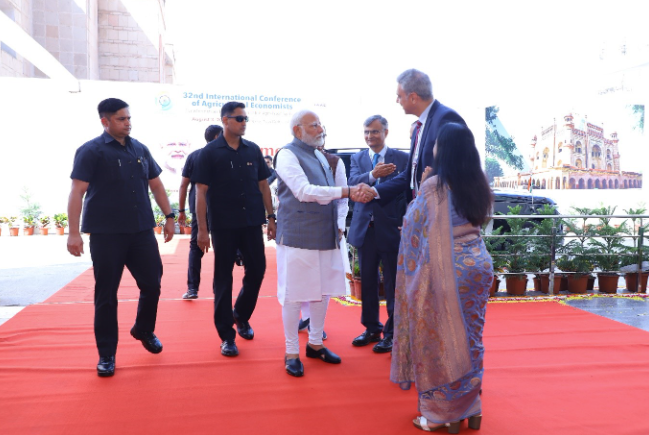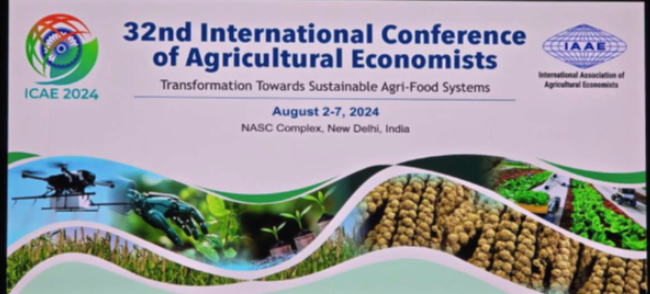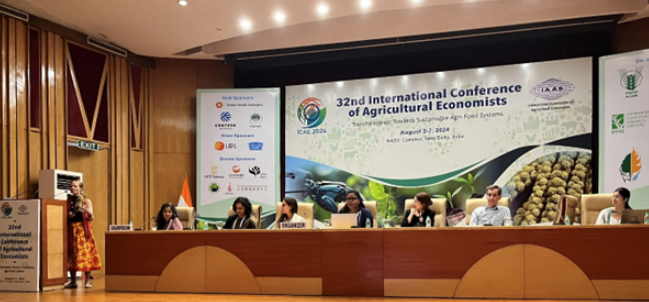
24 Oct Food system transformation towards sustainability: Insights from the 32nd ICAE in New Delhi, India
Agricultural economics stands as a dynamic and multifaceted field, bringing economic realities of food production, distribution, and consumption together. In recent years, the discipline has increasingly focused on addressing global challenges such as food security, climate change, and sustainable development. The 32nd International Conference of Agricultural Economists (ICAE) was held in August 2024 to bring world experts together to address these pressing issues and share cutting-edge research. In this Thought for Food, Dr Mahya Tavan shares her insights on the 32nd ICAE conference, highlighting how economists are tackling some of the world’s most complex problems.
India, a nation with a rich history and vibrant culture, recently hosted the International Conference of Agricultural Economists (ICAE) for the second time. The first ICAE in India took place 65 years ago, shortly after the country gained independence in 1947. The conference, themed “Transformation Towards Sustainable Agri-Food Systems”, was inaugurated by Narendra Modi, Prime Minister of India. Modi highlighted the remarkable progress India has achieved, especially in transforming its food system over the past 65 years. Today, India is a food surplus nation, standing as the largest producer of milk, contributing one-quarter of global production. In his address, PM Modi extended a warm welcome to delegates on behalf of 120 million farmers, including over 30 million women farmers, 30 million fishermen, and 80 million livestock farmers in the country.


The conference attracted around 1,000 delegates from 75 countries, featuring a series of presentations and discussions on key food system issues and the urgent need for food system transformation. As nicely put by Professor Hermann Lotze-Campen, a lead scientist at Potsdam Institute for Climate Impact Research (PIK), the global food system has achieved “something of a miracle” in keeping up with the population growth. However, modern food systems are contributing to major global challenges, including hunger, obesity, biodiversity loss, environmental damage, and climate change. Professor Lotze-Campen later highlighted a modeling framework called MAgPIE, Model of Agricultural Production and its Impact on the Environment, led by PIK. MAgPIE projects how the agriculture and food sector may change over time given a consistent set of assumptions and constraints. Recent projections using MAgPIE (available as a preprint, therefore not peer-reviewed) shows that transforming the food system can lead to significant improvements in health and environmental and economic sustainability. But, modelled transformation scenarios often involve trade-offs such as increasing expenditure on agricultural products or reduced employment in the agriculture sector. However, one of the modelled interventions stood out with fewer trade-offs while offering multiple co-benefits: dietary change.
To discuss some of the complexities of dietary change, the Global Alliance for Improved Nutrition (GAIN) organised a symposium titled “Healthy, Sustainable, and Affordable Diets: New Methods and Tools for Evidence-Based Policymaking and Programming” on the fourth day of the 32nd ICAE. This symposium focused on data-driven strategies for understanding various pillars of food sustainability ranging from nutritional value, environmental impacts, costs, and acceptability of diets.

Identifying Nutritious Foods with Low Environmental Impacts
To provide scientific evidence for guiding consumers and decision-makers on how individual foods contribute to sustainable diets, the opening talk at the symposium discussed methods for identifying foods with high nutritional value and low environmental footprints per unit of nutrition. This approach, known as nutritional life cycle assessment (nLCA), evaluates the environmental impacts of various foods while considering their nutritional value, helping to capture potential trade-offs between nutritional quality and environmental impacts. As the field of nLCA progresses, there is a growing need for advanced nutrient metrics that enable more nutritionally relevant assessments of the environmental impacts of foods. During the talk, a new nutrient profiling model developed by the researchers at GAIN was introduced. This model, called the Nutritional Value Score, offers data-driven evidence to select foods that are most efficient in providing nutrients while imposing the least environmental burden. However, ensuring access to foods with high Nutritional Value Scores is crucial for their implementation in diets, a topic explored further in the discussion by Professor William Masters, author of the recently published book Food Economics.
Targeting Nutrient-Rich Foods for Bottom-of-Pyramid Consumers
Professor Masters examined the cost of incorporating nutrient-rich foods into diets compared to least-cost diets for bottom-of-pyramid (BoP) consumers in Ethiopia, Nigeria, Kenya, and Mozambique. His team analysed the additional costs and changes in affordability when adding dairy, eggs, vegetables, dried fish, and chicken to model diets that meet dietary guidelines. The findings showed that the nutrient-rich foods identified by nutrition programs, such as those highlighted by the nLCA method, are often among the most affordable options for meeting nutrient requirements without significant additional expense. However, healthy diets remain generally inaccessible for most BoP consumers, with considerable variations in cost and affordability across regions. This highlights the importance of understanding sustainable healthy diets within specific geographic contexts, a principle reflected in SNi’s iOTA Model®, also discussed at the symposium.
Optimising Diets with The iOTA Model®
The iOTA Model® is a country-specific dietary optimisation modelling tool that can optimise diets across various pillars of sustainable healthy diets: nutrition, environmental impact, affordability and consumer acceptability. This model offers an innovative framework for consolidating fragmented data, delivering thorough insights for those concerned with diet sustainability. By employing optimisation techniques like those in the iOTA Model®, policymakers and practitioners can develop effective strategies tailored to local needs. The iOTA Model® is expected to be publicly available on the SNi website in the near future.
The ICAE 2024 conference stood out as a crucial platform, bringing together policymakers and scientists from around the world to address pressing issues in the food system such as supply chain disruptions, the climate crisis, and the urgency for global action toward the UN’s goal of ending hunger by 2030. It was both unconventional and inspiring to see policymakers actively participating in a scientific gathering, and even more encouraging to witness nutrition receiving significant focus in a traditionally economics-centric forum.
This Thought of Food was written by our Postdoctoral Research Fellow, Dr Mahya Tavan.





